An imaging technique has been developed by researchers at St Andrews University which could allow more detailed early diagnosis of cancer.
The innovative way to optically image through tissue had previously been thought impossible by some experts.
The St Andrews team say it could also provide a more detailed understanding of other diseases, including degenerative brain diseases.
The technique allows scientists to see deeper into tissue using light.
Researcher Adrià Escobet-Montalbán, Marie Curie fellow at St Andrews, said: “Our approach shows an innovative way to tackle a longstanding problem in imaging.
“It is exciting to see the response we have got from the international community as many people thought what we have done is impossible with light.”
Professor Kishan Dholakia, from the university’s School of Physics and Astronomy, said: “This is a timely breakthrough and I hope it leads to new ways of thinking about imaging at depth.”
A UK-wide research team was led by the Fife university, involving Southampton University and the Cancer Research UK Edinburgh Centre at Edinburgh University.
Its findings were published in the journal Science Advances.









